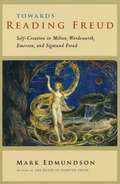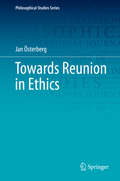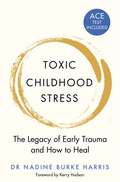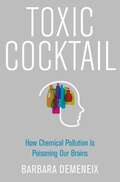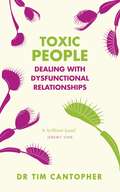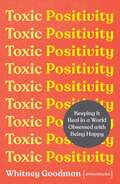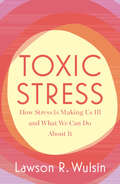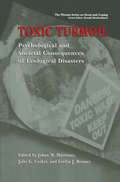- Table View
- List View
Towards Reading Freud: Self-Creation in Milton, Wordsworth, Emerson, and Sigmund Freud
by Mark EdmundsonWhen most critics were using Freudian theories to study literature, Mark Edmundson read Freud’s writings as literature alongside the works of poets grappling with the heady issues of desire, narcissism, and grief. Towards Reading Freud weighs the psychoanalyst’s therapeutic directives against his more visionary impulses in a magisterial comparative study of such writers as Shakespeare, Wordsworth, Emerson, and Keats. Cross-fertilizing psychological doctrine with the literary canon, this richly informed volume forges a new understanding of Freud’s writings on the self. “Marvelous. . . . Edmundson’s book offers an extraordinary challenge both to practicing analysts and to a scholarly community which all too uncomplainingly inhabits and reinforces the Freudian paradigm of interpretation. Edmundson reinvents an adventurous and dissident Freud as an antidote to . . . weary psychoanalytic commonplaces.”—Malcolm Bowie, Raritan “This book takes a distinguished place in the ongoing effort to recontextualize Freud by stressing the literary, rather than the scientific roots and character of his theory.”—Virginia Quarterly Review
Towards Reunion in Ethics (Philosophical Studies Series #138)
by Jan ÖsterbergThis posthumous publication attempts to answer the question of what moral code is the most reasonable. Philosophers often turn to consequentialism or deontological ethics to address this issue. As the author points out, each has valid arguments but each is unable to get the other side to agree. To rectify this, he proposes a third way. Inside, readers will discover a theory that tries to do justice to both sides. The author first details consequentialism and deontological ethics. He also explains their fundamental conflict. One holds the view that you should do what has the best consequences. The other believes that there are actions which are wrong to do even if they have the best consequences. Next, the volume considers various ways to solve this conflict. Would rejecting one theory work? Or, is it possible to somehow reconcile them. The author shows why these solutions fail. He then goes on to present his own. The resulting contractual theory brings together the two opposing ethical convictions. It proposes that what is right and wrong depends on what norms people would agree to. Throughout, coverage explores the psychological, sociological, and historical background of the moral theories discussed. The reason is that moral theories are embedded in social and psychological contexts. They are better understood when the contexts are explicit. This key feature distinguishes the volume from other works in moral philosophy.At the time of his death in July 2011, Jan Österberg was close to completing this manuscript. It was taken up and fully completed by Erik Carlson and Ryszard Sliwinski, both of Uppsala University.
Toxic: Tackling 'Razor' and Finding the Real Me
by Neil Ruddock'Neil's book has given me a new-found appreciation of how he used the "Razor" alter ego to mask what he was going through. The recent turnaround in him, both physical and mental, is a revelation.' ALAN SHEARER'Love Neil Ruddock. One of the old school. He's honest and funny as f**k. A beautiful read and a strong bit of memoir. Well done son.' DANNY DYER'You think you know "Razor" Ruddock? Well, think again. This is a courageous and fascinating autobiography by my ex-teammate, a book which will inspire so many others to confront their past and change their life.' ROBBIE FOWLER'Neil has always been the life and soul of the party but I can't tell you how much Toxic has given me a more rounded picture of him. To have the strength and determination to transform his life is a special thing.' ROBBIE WILLIAMS'Neil's book blew my mind. Now I understand my friend's journey to finally being comfortable in his own skin.' IAN WRIGHTNeil 'Razor' Ruddock tells the inspiring and uplifting story of how he faced the battle of his life: to become a different person.In this inspiring and uplifting memoir, Neil Ruddock charts his toxic journey of self-destruction, a path littered with food addiction, plummeting self-confidence and a dangerous relationship with drink which took him to the brink of death.'Razor' was his caricature of the larger-than-life football hardman, a persona which turned from a natural extension of Ruddock's character to a comfort blanket to smother every mood, every emotion. When his front door closed, the laughter stopped. He was depressed and despairing. Football had institutionalised him. Talking about his inner feelings wasn't an option, owning up to mental health issues was an absolute no-no.In a remarkable series of confessions, and with his trademark humour and brutal honesty, Ruddock recounts how he spiralled so far out of control that he lost sight of who he really was. No matter how he was feeling, he reached for the same old answer - the mask of 'Razor' and a big night out.Following the fitting of a pacemaker and drastic stomach surgery, Ruddock has lost nine stones, firmly pressed the reset button on his life, and found the strength to free himself of the shackles of the bloke he thought he needed to be in order to become the man he always knew he was.Toxic tells the story of how Ruddock faced the battle of his life: to become a different person. No longer does he feel the need to be anything but his true self. As he now says: I'm half the man I used to be, but twice the man I used to be.'
Toxic Childhood Stress: The Legacy of Early Trauma and How to Heal
by Dr Nadine Harris*Previously published as The Deepest Well*‘Finally after thirty years, I finally understood . . . this book holds the answers you’ve been searching for.’ Kerry HudsonThe Surgeon General of California reveals pioneering research on how childhood stress leads to lifelong health problems and what we can do to break the cycle.Perfect for fans of The Body Keeps the Score by Bessel van der Kolk, this eye-opening book includes a free Adverse Childhood Experience test and looks at the widespread crisis of trauma and childhood adversity through the objective lens of science and medicine, providing a roadmap for deeper understanding and change. It is vital now more than ever, as a result of the Coronavirus pandemic, that we find a way to address, understand and heal trauma.Two thirds of us have experienced at least one adverse childhood experience, from the likes of bereavement and divorce to abuse and neglect. In Toxic Childhood Stress Dr Burke Harris reveals the science behind childhood adversity and offers a new way of understanding the adverse events that affect us throughout our lifetime. Based on her own groundbreaking clinical work and public leadership, Dr Burke Harris shows us how we can disrupt this cycle through interventions that help retrain the brain and body, foster resilience, and help children, families, and adults live healthier, happier lives.When a young boy walked into Dr Nadine Burke Harris's clinic he looked healthy for a preschooler. But he was seven, and hadn't grown a centimetre since a traumatic event when he was four. At that moment Dr Burke Harris knew that her gut feeling about a connection between childhood stress and future ill health was more than just a hunch – and she began her journey into groundbreaking research with stunning results.
Toxic Cocktail: How Chemical Pollution Is Poisoning Our Brains
by Barbara DemeneixIn today's world, everyone carries a toxic load of dozens of industrially produced chemicals in their bloodstream. Not only do these adversely affect the health of adults and children, but also, and more worryingly, they damage the development of unborn infants. The amniotic fluid of pregnant women has been found to contain a variety of chemicals, such as pesticides, plasticizers, disinfectant products, flame-retardants, surfactants and UV filters, many of which interfere with fetal physiology, especially thyroid hormone action. Thyroid hormone is vital for brain development, particularly for the fetus during pregnancy and for toddlers. In fact, children born to women who lack this thyroid hormone (or who are unwittingly exposed to thyroid-disrupting chemicals) have lower IQs and more neurodevelopmental problems. Evolution of the human brain has involved multiple changes and processes dependent on thyroid hormone. The urgent question thus arises: Is chemical pollution poisoning brain development and reversing evolution's most outstanding achievement: the human brain? And if so, as this book convincingly illuminates, what can be done about it both collectively and individually? Toxic Cocktail provides a clear view of how many environmental chemicals interfere with brain development. As a result, this book looks at how we define and test IQ, the evidence for IQ loss, and how chemical pollution and thyroid hormone disruption can be actors in this process, as well as increasing neurodevelopmental disease risk.
Toxic Cocktail: How Chemical Pollution Is Poisoning Our Brains
by Barbara DemeneixIn today's world, everyone carries a toxic load of dozens of industrially produced chemicals in their bloodstream. Not only do these adversely affect the health of adults and children, but also, and more worryingly, they damage the development of unborn infants. The amniotic fluid of pregnant women has been found to contain a variety of chemicals, such as pesticides, plasticizers, disinfectant products, flame-retardants, surfactants and UV filters, many of which interfere with fetal physiology, especially thyroid hormone action. Thyroid hormone is vital for brain development, particularly for the fetus during pregnancy and for toddlers. In fact, children born to women who lack this thyroid hormone (or who are unwittingly exposed to thyroid-disrupting chemicals) have lower IQs and more neurodevelopmental problems. Evolution of the human brain has involved multiple changes and processes dependent on thyroid hormone. The urgent question thus arises: Is chemical pollution poisoning brain development and reversing evolution's most outstanding achievement: the human brain? And if so, as this book convincingly illuminates, what can be done about it both collectively and individually? Toxic Cocktail provides a clear view of how many environmental chemicals interfere with brain development. As a result, this book looks at how we define and test IQ, the evidence for IQ loss, and how chemical pollution and thyroid hormone disruption can be actors in this process, as well as increasing neurodevelopmental disease risk.
Toxic Couples: The Psychology Of Domestic Violence
by Anna MotzDomestic violence is a major public health concern, affecting millions worldwide. It is underreported, often devastating and sometimes ends in murder. In Toxic Couples: The Psychology of Domestic Violence, Anna Motz integrates psychological and criminological data with clinical illustrations and discussion of current high-profile cases. She examines the complex manifestations and multiple causes of intimate partner violence. Motz disentangles the roles played by those involved and examines the addictive nature of these damaging partnerships. The book describes various forms of abuse, including physical, sexual and emotional, and analyses how intimate partner violence can escalate to murder. She explores important factors including: the role of addiction; homelessness and vulnerability; the intergenerational transmission of abuse; sadomasochistic relationships; honour-based violence. The book emphasizes the significance of female- as well as male-perpetrated violence and outlines the powerful impact on the children of abusive parents, extending the clinical awareness of professionals working with those affected. Toxic Couples: The Psychology of Domestic Violence is ideal for clinicians working with the victims and perpetrators of intimate partner violence, for students of psychology, gender studies and social care courses and for anyone interested in the psychological forces behind violence in relationships.]
Toxic Couples: The Psychology Of Domestic Violence
by Anna MotzDomestic violence is a major public health concern, affecting millions worldwide. It is underreported, often devastating and sometimes ends in murder. In Toxic Couples: The Psychology of Domestic Violence, Anna Motz integrates psychological and criminological data with clinical illustrations and discussion of current high-profile cases. She examines the complex manifestations and multiple causes of intimate partner violence. Motz disentangles the roles played by those involved and examines the addictive nature of these damaging partnerships. The book describes various forms of abuse, including physical, sexual and emotional, and analyses how intimate partner violence can escalate to murder. She explores important factors including: the role of addiction; homelessness and vulnerability; the intergenerational transmission of abuse; sadomasochistic relationships; honour-based violence. The book emphasizes the significance of female- as well as male-perpetrated violence and outlines the powerful impact on the children of abusive parents, extending the clinical awareness of professionals working with those affected. Toxic Couples: The Psychology of Domestic Violence is ideal for clinicians working with the victims and perpetrators of intimate partner violence, for students of psychology, gender studies and social care courses and for anyone interested in the psychological forces behind violence in relationships.]
Toxic Cultures at Work: The Eight Drivers of a Toxic Culture and a Process for Change
by James CannonAround the world and across industries, toxic workplaces are in the news. Taking a holistic approach, this book gives a succinct summary of how toxic cultures develop and shows how they can be remedied with practical takeaways for organisations. Existing books on toxic culture either skim the surface of the latest scandal or take a theoretical approach of limited use to practitioners trying to improve their organisations. Now, organisational development expert James Cannon presents an all-in-one resource based on organisational and individual psychology research that offers actionable suggestions for required change. Cannon provides a framework to understand the complexities of a toxic culture, identifying eight drivers: power, leadership personalities, values, organisation design, formal and informal systems, relations with the external environment and individual systems of motivation and reward. The book also offers a comprehensive toolkit with questionnaires and checklists to manage and achieve cultural change. Professionals and students in organisational psychology, business, and change management, as well as those with an interest in the political and social issues raised by toxic cultures, will appreciate this guide on how to tackle a problem that is much discussed but seldom solved.
Toxic Cultures at Work: The Eight Drivers of a Toxic Culture and a Process for Change
by James CannonAround the world and across industries, toxic workplaces are in the news. Taking a holistic approach, this book gives a succinct summary of how toxic cultures develop and shows how they can be remedied with practical takeaways for organisations. Existing books on toxic culture either skim the surface of the latest scandal or take a theoretical approach of limited use to practitioners trying to improve their organisations. Now, organisational development expert James Cannon presents an all-in-one resource based on organisational and individual psychology research that offers actionable suggestions for required change. Cannon provides a framework to understand the complexities of a toxic culture, identifying eight drivers: power, leadership personalities, values, organisation design, formal and informal systems, relations with the external environment and individual systems of motivation and reward. The book also offers a comprehensive toolkit with questionnaires and checklists to manage and achieve cultural change. Professionals and students in organisational psychology, business, and change management, as well as those with an interest in the political and social issues raised by toxic cultures, will appreciate this guide on how to tackle a problem that is much discussed but seldom solved.
Toxic Interactions and the Social Geography of Psychosis: Reflections on the Epidemiology of Mental Disorder (The International Society for Psychological and Social Approaches to Psychosis Book Series)
by Hugh MiddletonToxic Interactions is a review of quantitative research revealing how urban living, trauma, ethnicity, stress and familial influence the risk of troubling psychotic experiences. Each of these is reviewed in search of their social implications, and a constructivist approach identifies their common threads. The contributions of newer psychotherapeutic approaches such as Open Dialogue and Recovery programmes are considered, and a consistent interpretation emerges; that is not the observable features of disturbed mental state that deserve key attention, but how these are generally understood by others, and in particular the 'client's' close associates. Toxic Interactions and the Social Geography of Psychosis will be welcomed by all who find conventional approaches to mental health difficulties unsatisfactory, whether that is as a practitioner frustrated by the counter-productive expectations of their institutional setting, an academic exploring different perspectives a 'service user' disappointed by not experiencing the care they feel is needed, or as third party perplexed by the contradictions of contemporary psychiatry.
Toxic Interactions and the Social Geography of Psychosis: Reflections on the Epidemiology of Mental Disorder (The International Society for Psychological and Social Approaches to Psychosis Book Series)
by Hugh MiddletonToxic Interactions is a review of quantitative research revealing how urban living, trauma, ethnicity, stress and familial influence the risk of troubling psychotic experiences. Each of these is reviewed in search of their social implications, and a constructivist approach identifies their common threads. The contributions of newer psychotherapeutic approaches such as Open Dialogue and Recovery programmes are considered, and a consistent interpretation emerges; that is not the observable features of disturbed mental state that deserve key attention, but how these are generally understood by others, and in particular the 'client's' close associates. Toxic Interactions and the Social Geography of Psychosis will be welcomed by all who find conventional approaches to mental health difficulties unsatisfactory, whether that is as a practitioner frustrated by the counter-productive expectations of their institutional setting, an academic exploring different perspectives a 'service user' disappointed by not experiencing the care they feel is needed, or as third party perplexed by the contradictions of contemporary psychiatry.
Toxic Nourishment
by Michael EigenThis book portrays a range of individuals who seek nourishment from poisons or, to variable extents, are poisoned by the nourishment they seek. It describes the analyses leading to de-programming the patients from their toxins and intoxicators.
Toxic Nourishment
by Michael EigenThis book portrays a range of individuals who seek nourishment from poisons or, to variable extents, are poisoned by the nourishment they seek. It describes the analyses leading to de-programming the patients from their toxins and intoxicators.
Toxic Nourishment and Damaged Bonds in the Work of Michael Eigen: Working with the Obstructive Object
by Loray Daws Keri S. CohenToxic Nourishment and Damaged Bonds in the Work of Michael Eigen examines Eigen’s rich phenomenological work on the Obstructive Object.The contributors to this collection explore the core theme with reference to key Eigen works, including The Psychotic Core, Psychic Deadness, Toxic Nourishment, and Damaged Bonds. This volume seeks to elaborate on the Obstructive Object through essays and poems that include poignant clinical examples, the impact of exceptionally traumatized patients on their analysts, literature comparisons, and the more "mystical aspect" of Eigen’s influence on working with the obstructive object. Essays draw from Virginia Woolf, Elena Ferrante, Wilfred Bion, D.W. Winnicott, Andrè Greene, Christopher Bollas, and Adam Phillips, among many others, in exploring injury-rage, unwanted patients, psychoanalytic faith, toxic nourishment, and damaged bonds.Toxic Nourishment and Damaged Bonds in the Work of Michael Eigen will greatly interest psychoanalysts, psychotherapists, and those interested in psychoanalytic and spiritual psychology.
Toxic Nourishment and Damaged Bonds in the Work of Michael Eigen: Working with the Obstructive Object
Toxic Nourishment and Damaged Bonds in the Work of Michael Eigen examines Eigen’s rich phenomenological work on the Obstructive Object.The contributors to this collection explore the core theme with reference to key Eigen works, including The Psychotic Core, Psychic Deadness, Toxic Nourishment, and Damaged Bonds. This volume seeks to elaborate on the Obstructive Object through essays and poems that include poignant clinical examples, the impact of exceptionally traumatized patients on their analysts, literature comparisons, and the more "mystical aspect" of Eigen’s influence on working with the obstructive object. Essays draw from Virginia Woolf, Elena Ferrante, Wilfred Bion, D.W. Winnicott, Andrè Greene, Christopher Bollas, and Adam Phillips, among many others, in exploring injury-rage, unwanted patients, psychoanalytic faith, toxic nourishment, and damaged bonds.Toxic Nourishment and Damaged Bonds in the Work of Michael Eigen will greatly interest psychoanalysts, psychotherapists, and those interested in psychoanalytic and spiritual psychology.
Toxic People: Dealing With Dysfunctional Relationships
by Tim Cantopher'A brilliant book about how we identify the often-charming people who only spread misery.' Jeremy Vine, BBC Radio 2BMA MEDICAL AWARDS 2020: HIGHLY COMMENDEDSome people are so stressful, they can actually make us ill. Gameplayers, bullies, users and abusers - all pose a risk to our health and welfare if we don't take action. This book presents the tools we need to deal with the toxic people in our lives who drain our energy. It explains how to make healthy relationship choices, set proper boundaries and recognize the red flags that should alert us to avoid certain people. Whether you are struggling with a narcissistic partner, or dealing with a bullying boss or a sociopathic colleague, there is practical advice that will help you not only to protect your mental wellbeing but also to thrive. You will understand the nature of the toxic workplace - how to avoid it and if necessary survive within it. If you're surrounded by the takers of this world, read this book and gain the freedom to make your own choices and live your own life.
Toxic Positivity: Keeping It Real in a World Obsessed with Being Happy
by Whitney Goodman'I really felt like I came away with a new perspective. This book will make you want to bin your gratitude journal in the best possible way' Stylist 'This trailblazing book will help you transform your perspective about positivity' Nedra Glover Tawwab, bestselling author of Set Boundaries, Find Peace'Finally a book that explains exactly why 'positivity at all costs' backfires, and teaches us how to process our pain instead of pretending it doesn't exist.' Caroline Dooner, author of The F*uck It Diet'The counterbalance to a world that preaches 'look on the bright side' whenever life gets tough' Elizabeth Earnshaw, relationship expert and author of I Want This To WorkEvery day, we're bombarded with pressure to be positive. From 'good vibes only' and 'life is good' memes, to endless advice, to 'look on the bright side,' we're constantly told that the key to happiness is silencing negativity wherever it crops up, in ourselves and in others. Even when faced with illness, loss, breakups, and other challenges, there's little space for talking about our real feelings-and processing them so that we can feel better and move forward.But if all this positivity is the answer, why are so many of us anxious, depressed, and burned out?In this refreshingly honest guide, sought-after therapist Whitney Goodman shares the latest research along with everyday examples and client stories that reveal how damaging toxic positivity is to ourselves and our relationships, and presents simple ways to experience and work through difficult emotions. The result is more authenticity, connection, and growth - and ultimately, a path to showing up as you truly are.
The Toxic Schoolhouse (Work, Health and Environment Series)
by Madeleine Kangsen Scammell Charles LevensteinThe Toxic Schoolhouse is a collection of articles on chemical hazards endangering students, teachers, and staff in the education system of the United States and Canada. Some of the articles were originally published in a special issue of New Solutions: A Journal of Occupational and Environmental Policy, but all have been updated and several new articles have been added. The book is organized in three sections. The first describes problems ranging from the failures of coordination, monitoring, and siting of school buildings to the hazards of exposure to toxic substances, including lead and PCBs. The second section captures the voices of activists seeking change and describes community and union organizing efforts to improve school conditions. The third section covers policy "solutions." The authors include academics, union staff and rank-and-file activists, parent organization leaders, and public health professionals.
The Toxic Schoolhouse (Work, Health and Environment Series)
by Madeleine Kangsen Scammell Charles LevensteinThe Toxic Schoolhouse is a collection of articles on chemical hazards endangering students, teachers, and staff in the education system of the United States and Canada. Some of the articles were originally published in a special issue of New Solutions: A Journal of Occupational and Environmental Policy, but all have been updated and several new articles have been added. The book is organized in three sections. The first describes problems ranging from the failures of coordination, monitoring, and siting of school buildings to the hazards of exposure to toxic substances, including lead and PCBs. The second section captures the voices of activists seeking change and describes community and union organizing efforts to improve school conditions. The third section covers policy "solutions." The authors include academics, union staff and rank-and-file activists, parent organization leaders, and public health professionals.
Toxic Stress: A step-by-step guide to managing stress (The Flag Series #4)
by Dr Harry BarryIdentify and manage stress with this practical, seven-step programme by bestselling author and GP, Dr Harry BarryIn the world we live in, stress comes from a multiple number of sources, including pressures at work, relationship difficulties and illness. Most people can usually take what life throws at them; but when stress builds up, it can overwhelm an individual and lead to potentially serious health problems. Toxic stress is an indispensable tool on coping with the stresses of modern life. By identifying the different kinds of stress and in particular the dangers of 'toxic' stress, Dr Barry shows us how to discover where our stress is coming from and how we can effectively confront, manage and reduce it in our lives.Previously published as Flagging Stress: Toxic Stress and How to Avoid It, this edition has been fully revised and updated.
Toxic Stress: How Stress Is Making Us Ill and What We Can Do About It
by null Lawson R. WulsinOur stress response system is magnificent - it operates beneath our awareness, like an orchestra of organs playing a hidden symphony. When we are healthy, the orchestra plays effortlessly, but what happens when our bodies face chronic stress, and the music slips out of tune? The alarming rise of stress-related conditions, such as heart disease, diabetes, and depression, show the price we're paying for our high-pressure living, while global warming, pandemics and technology have brought new kinds of stress into all our lives. But what can we do about it? Explore the fascinating mysteries of our hidden stress response system with Dr. Wulsin, who uses his decades of experience to show how toxic stress impacts our bodies; he gives us the expert advice and tools needed to prevent toxic stress from taking over. Chapter by chapter, learn to help your body and mind recover from toxic stress.
Toxic Turmoil: Psychological and Societal Consequences of Ecological Disasters (Springer Series on Stress and Coping)
by Evelyn J. Bromet Julie G. Cwikel Johan M. HavenaarWhen an accident involves many people and when its consequences are many and serious, we speak of a disaster. Disasters have the same causal fac tors as accidents: they differ from accidents by the gravity of consequences, not by causes. The action of a single individual may result in thousands of deaths and huge financial losses. The metal fatigue of a screw may, by a chain of events, cause an explosion killing hundreds or lead to a break in a dam and a devastating flood. The fact that minor and unpredictable acts can lead to disasters is im portant because it allows us to predict that the years to come will bring with them more disasters with ever more severe consequences. The density ofhu man populations is growing. By the year 2025 some four fifths of the world's population will be living in urban settings. An explosion or a gas leak in a densely populated area will cause incomparably more damage than a simi lar event in a rural area. Modern technology is immensely powerful (and its power is continuing to grow) and can be used in a disastrous manner. Ag gression is just as possible now as it was in the past, but the tools of aggression are vastly more dangerous than ever before. This book, edited by Johan M. Havenaar, Julie G. Cwikel, and Evelyn J. Bromet, is therefore very timely.
Toxic Wealth: How the Culture of Affluence Can Harm Us and Our Children (Non-ser.)
by Orla Cashman James A. TwaiteThis volume spotlights the unique problems that often accompany a high-income lifestyle and offers guidelines that can help individuals avoid the pitfalls wealth may bring.Two therapists show how the culture of affluence in America creates unique problems for wealthy adults and children, often resulting in poor psycho-social adjustment, anxiety, low self-esteem, and the inability to have fun. The affluent are under tremendous pressure to achieve. They are subject to a myriad of negative stereotypes that make it difficult for them to have a normal social life. They are taken advantage of, preyed upon, and ridiculed. When they seek professional help for their problems, they may receive little sympathy.This book is a sage and insightful primer aimed at all readers who have some wealth, whether inherited or amassed through personal effort. The consciousness-raising here includes vignettes from the treatment rooms of the authors, who have helped many wealthy individuals and families deal with the fallout from the myths with which our culture burdens them. Specific guidelines on how to deal with problems are presented.
Toxikologie für Einsteiger
by Holger Barth Katharina Ernst Panagiotis PapatheodorouIn diesem kurzen Lehrbuch werden grundlegende wissenschaftliche und klinische Aspekte der Toxikologie dargestellt und ihre wichtigsten Inhalte, Ziele und Aufgaben beschrieben. Das Buch richtet sich an Studierende biowissenschaftlicher und chemischer Bachelor- und Masterstudiengänge, die Toxikologie als medizinisches Wahlfach belegen. Zu Beginn werden wichtige toxikologische Fachbegriffe definiert, um den Einstieg zu erleichtern. Es wird beschrieben was ein „Gift“ ausmacht und wie Giftstoffe in den menschlichen Körper gelangen können. Akute Vergiftungen, ihre Ursachen und die wichtigsten Maßnahmen für ihre Therapie werden im Einzelnen vorgestellt. Der Großteil des Lehrbuches beschreibt die Wirkung ausgewählter, medizinisch relevanter Giftstoffe aus Natur und Umwelt, häuslicher Umgebung und dem Arbeitsplatz wie Toxine aus Tieren, Pflanzen, Pilzen und Bakterien, Giftgase, Stäube, Metalle, Pestizide, Lösungsmittel und Alkohol. Am Ende werden die grundlegenden Prinzipien der chemischen Kanzerogenese zusammengefasst und die krebsauslösende Wirkung einiger toxikologisch wichtiger Substanzen exemplarisch vorgestellt sowie rechtliche Grundlagen im Umgang mit Giftstoffen zusammengefasst.
